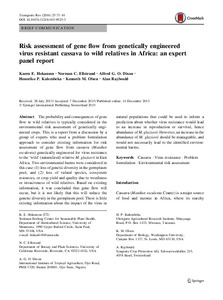| dc.contributor.author | Hokanson, K.E. |
| dc.contributor.author | Ellstrand, N.C. |
| dc.contributor.author | Dixon, A. |
| dc.contributor.author | Kulembeka, H.P. |
| dc.contributor.author | Olsen, K.M. |
| dc.contributor.author | Raybould, A. |
| dc.date.accessioned | 2019-12-04T10:58:22Z |
| dc.date.available | 2019-12-04T10:58:22Z |
| dc.date.issued | 2016-02-15 |
| dc.identifier.citation | Hokanson, K.E., Ellstrand, N.C., Dixon, A., Kulembeka, H.P., Olsen, K.M., & Raybould, A. (2016). Risk assessment of gene flow from genetically engineered virus resistant cassava to wild relatives in Africa: an expert panel report. Transgenic Research, 25(1), 71-81. |
| dc.identifier.issn | 0962-8819 |
| dc.identifier.uri | https://hdl.handle.net/20.500.12478/975 |
| dc.description | Published online: 14 December 2015 |
| dc.description.abstract | The probability and consequences of gene flow to wild relatives is typically considered in the environmental risk assessment of genetically engineered crops. This is a report from a discussion by a group of experts who used a problem formulation approach to consider existing information for risk assessment of gene flow from cassava (Manihot esculenta) genetically engineered for virus resistance to the ‘wild’ (naturalized) relative M. glaziovii in East Africa. Two environmental harms were considered in this case: (1) loss of genetic diversity in the germplasm pool, and (2) loss of valued species, ecosystem resources, or crop yield and quality due to weediness or invasiveness of wild relatives. Based on existing information, it was concluded that gene flow will occur, but it is not likely that this will reduce the genetic diversity in the germplasm pool. There is little existing information about the impact of the virus in natural populations that could be used to inform a prediction about whether virus resistance would lead to an increase in reproduction or survival, hence abundance of M. glaziovii. However, an increase in the abundance of M. glaziovii should be manageable, and would not necessarily lead to the identified environmental harms. |
| dc.format.extent | 71-81 |
| dc.language.iso | en |
| dc.subject | Cassava |
| dc.subject | Environmental Risk Assessment |
| dc.title | Risk assessment of gene flow from genetically engineered virus resistant cassava to wild relatives in Africa: an expert panel report |
| dc.type | Journal Article |
| dc.description.version | Peer Review |
| cg.contributor.crp | Roots, Tubers and Bananas |
| cg.contributor.affiliation | University of Minnesota |
| cg.contributor.affiliation | University of California |
| cg.contributor.affiliation | International Institute of Tropical Agriculture |
| cg.contributor.affiliation | Ukiriguru Agricultural Research Institute, Tanzania |
| cg.contributor.affiliation | Washington State University |
| cg.contributor.affiliation | Syngenta Crop Protection AG |
| cg.coverage.region | West Africa |
| cg.coverage.country | Nigeria |
| cg.isijournal | ISI Journal |
| cg.authorship.types | CGIAR and developing country institute |
| cg.authorship.types | CGIAR and advanced research institute |
| cg.iitasubject | Cassava |
| cg.journal | Transgenic Research |
| cg.howpublished | Formally Published |
| cg.accessibilitystatus | Limited Access |
| local.dspaceid | 77754 |
| cg.targetaudience | Scientists |
| cg.identifier.doi | https://dx.doi.org/10.1007/s11248-015-9923-3 |

